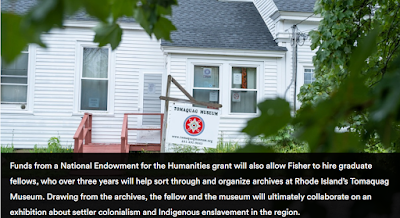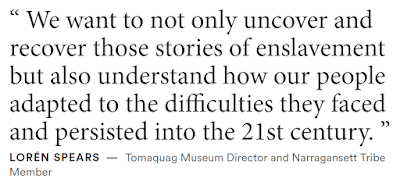Volunteers and Native American leaders have recovered thousands of Indigenous enslavement records
The
Wampanoags were shipped by boat to Tangier, once an English colony and now a
major Moroccan city. When they arrived, they wrote to Massachusetts colony
pastor and missionary John Eliot, whom they considered an ally, in a panic.
“They
essentially wrote, ‘We were enslaved during the war, we’re serving in Tangier,
and our simple request is just to be returned to our homeland,’” said Linford
Fisher, an associate professor of history at Brown University. “As far as I can
tell, they were never able to leave. They never saw their families again, and
nothing was ever done.”
Their story, Fisher said, is one of countless heartbreaking tales of Indigenous enslavement that historians have only just begun to unearth in the past few decades. In 2015, in an effort to advance collaboration in the nascent effort, Fisher created Stolen Relations: Recovering Stories of Indigenous Enslavement in the Americas, an online repository that contains more than 4,400 records of Indigenous enslavement — and counting.
Originally created with his scholarly peers in mind, the project has now expanded to become an empowering tool for Indigenous communities and descendants of European colonizers alike who wish to confront their full, painful ancestral histories. It is also raising widespread awareness of Indigenous enslavement, a subject that’s long been omitted, glossed over or mentioned only obliquely in American classrooms.
“As the field kept on growing, and as I talked more and more with colleagues who were researching the same thing, I kept thinking that there should be some sort of centralized resource where we can all benefit from each other’s work,” Fisher said. “I hope the project will ultimately become a resource that is not only beneficial to researchers and educators but also to public historians, genealogists and tribal nations.”
Seven
years after its start, Stolen Relations is set to continue expanding, thanks to
a $350,000 grant from the National Endowment for the Humanities. The majority
of the grant will fund a redesigned, publicly accessible site for the online
repository, which is currently available only to registered users, most of them
scholars and community partners. According to Ashley Champagne, director of
Brown’s Center for Digital Scholarship and the longtime project manager of the
Stolen Relations repository, the website’s records will not only continue to
grow but will also be enriched by important cultural context provided by
regional Indigenous leaders.
“Most
people know so little about Indigenous enslavement, but creating a public
portal to more than 4,000 records could change that,” Champagne said. “Over
time, we hope to offer maps, timelines and multimedia that help people
understand how Indigenous enslavement shaped economies and people in the
Americas and scattered Indigenous communities around the world.”
The funds will also allow Fisher to hire graduate fellows, who over three years will help sort through and organize archives at Rhode Island’s Tomaquag Museum. The museum’s archives contain critically important records of Indigenous life in Southern New England, and many could shed light on yet more instances of Indigenous enslavement.
Drawing
from the archives, the fellow and the museum will ultimately collaborate on an
exhibition about settler colonialism and Indigenous enslavement in the region.
The exhibition will be on view at the museum and will later travel to Brown.
Lorén
Spears, director of the Tomaquag Museum, said the partnership will not only
expand public access to the museum’s estimated 100,000 records, offering
insights on Indigenous life in Southern New England more broadly. It will also
add needed dimension to Stolen Relations — humanizing its enslaved
subjects and emphasizing Indigenous peoples’ resilience.
“We want to not only uncover and recover those stories of enslavement but also understand how our people adapted to the difficulties they faced and persisted into the 21st century,” Spears said.
“Some Native people in this area were sent
to Bermuda to work on sugar cane plantations, and their descendants are now
reconnecting with relatives in New England and sharing how they kept and adapted
cultural traditions. It’s important to know that their ancestors were enslaved,
yes, but it’s equally important to celebrate their resilience and the
reconnection that is happening.”
The grant funds will also allow Stolen Relations to deepen its
already-close partnerships with tribal communities in Rhode Island,
Massachusetts, Connecticut and beyond, Fisher said. Three years of funds for a
summer tribal internship will give Fisher an opportunity to work with and learn
from young tribal members as he and his team continue to build and expand the
online repository. The grant will also support regular meetings with local
tribal leaders, who have for years provided crucial insights that have
transformed Stolen Relations.
“I
think one of the biggest positive outcomes of this project is that it not only
directs people to the past to learn about this important history, but it also
increases their awareness of Indigenous peoples today,” Fisher said. “Tribal
leaders have left their stamp all over this project, which I think leads people
to come away saying, ‘Wow, these people are still here; even after all they’ve
suffered, they’ve persisted with incredible resilience.’”
Long-forgotten
history
Across
the Americas, between 1492 and 1900, an estimated 2 million to 5.5 million
Indigenous people were summarily taken from their ancestral homelands and
forced into slavery. Some were made to work on farms and estates on the very
lands they once used freely, while others were sent to European cities and
colonial outposts in Africa and Asia.
Despite
the phenomenon’s huge scale, Fisher said, most Americans never learned about
Indigenous enslavement in school. That’s partly because European colonists
didn’t keep meticulous records of the Indigenous people they enslaved.
“It's
not like the transatlantic slave trade, where we have very clear shipping
records and plantation records where slaves were tabulated,” Fisher said.
“Indigenous slavery operated in this semi-legal realm and wasn’t always called
‘slavery.’ As a result, the documentation is much more sparse, and it takes
more work to turn up these stories.”
Fisher
believes the subject didn’t enter the national consciousness until 2003, when
two books on the subject won the Bancroft Prize — considered the
highest honor for American historians. Those books inspired a proliferation of
scholarship on Indigenous enslavement. In the last 20 years, facts have emerged
about European colonists’ past enslavement of Indigenous people in Brazil, the
Dominican Republic and other parts of the Caribbean and Spanish Americas.
The
topic gained even more momentum after 2016, when the book “The Other Slavery:
The Uncovered Story of Indian Enslavement in America” was shortlisted for the
Booker Prize. By the time the Black Lives Matter movement saw a resurgence in
2020, shedding light on widespread systemic racism, some K-12 teachers had already
begun introducing the subject of Indigenous slavery to their students,
alongside lessons on the transatlantic slave trade.
“I’ve had a few opportunities to participate in workshops for local high school teachers, and whenever I present, teachers always say, ‘This is crazy; I had no idea that it was happening here and it wasn’t just the Spanish [enslaving Native Americans],’” Fisher said. “They’ll say, ‘How can I incorporate this into my classroom lessons?’”
Fisher’s
own research on Indigenous enslavement began in 2011; he traveled to the United
Kingdom, the Caribbean and other sites where Indigenous peoples had been
enslaved. After several years in the field, he wished he could collaborate with
other scholars who were exploring the subject in Latin America, Brazil and
other parts of the world.
So
in 2015, he worked with Champagne to create the Stolen Relations website, a
repository that now contains those 4,400 historical records of Indigenous
slavery found in journals, property documents, newspapers, books and
manuscripts. Stolen Relations shares decades of research, fieldwork and
ancestral knowledge from approximately 60 contributors at Brown and across the
globe. Some are records of the enslaved, others of enslavers. Some contain
extremely detailed personal accounts, while others are brief: a name, maybe an
age.
Each
record offers but one anecdote — but together, Fisher said, they are an unsettling
reminder of the systematic violence and subjugation Europeans employed to build
their empires.
“This
is not just an add-on to the story of colonization,” Fisher said. “This is
fundamental to how the English succeeded in colonizing the Northeast. You don't
have vast areas of New England or the Mid-Atlantic or the South ‘available’ for
settlements if you haven't destabilized the existing Indigenous communities and
tribes over time through kidnapping and enslavement.”
A community-wide
project
This
isn’t the first time Stolen Relations has shifted direction in a beneficial
way. Fisher said that a few years after the repository’s original launch, he
and his colleagues realized it was missing something: perspective from
Indigenous peoples.
“We became convinced that this should be a collaborative project with tribes and Indigenous communities,” Fisher said. “That was a big pivot for us. It ceased to be simply an academic project that was serving the academic community.”
In Fall 2019, together with Rae Gould, executive director of Brown’s Native American and Indigenous Studies Initiative and a member of the Nipmuc Tribe of Massachusetts, and former Brown librarian Lydia Curliss, also a member of the Nipmuc Tribe, Fisher reached out to 15 regional tribes and communities to propose forming a Tribal Community Collaborators board for the project.
Since then, Indigenous leaders from across southern New England, including Spears, have met with Fisher, Gould and others at Brown twice a year to discuss the ongoing research and its online home.
Their meetings transformed the project — starting with its name. Originally called the Database of Indigenous Slavery in the Americas, the team renamed the website Stolen Relations after seeing firsthand how personal, and painful, its stories were to tribal leaders. Fisher recalled a moment when a Shinnecock leader, after learning that some of her ancestors had been enslaved, paused the meeting to offer a verbal apology to her forebears for the trials they’d endured.
“To academic researchers, slavery is largely about labor and economics,” Fisher said. “We make these nitpicky distinctions between slavery and servitude based on how people ended up in the position they were in. But watching Mohegan, Narragansett and Nipmuc leaders look at these documents for the first time and process the information they found really chastened me. Their attitude is, who cares whether it’s slavery or servitude? Who cares whether someone was kidnapped or whether they surrendered to the English to protect their family from harm? The result is the same: People were stolen from our communities.”
The tribal board also counseled Fisher to focus on collecting records of the enslavers as well as the enslaved; doing so could bolster the work of Native genealogists, since many Indigenous people were assigned their enslavers’ surnames.
The board also inspired Fisher and Champagne to add important contextual notes to the historical records. The website’s new notices about the documents’ harmful terminology and possible inaccuracies, Champagne said, help humanize Indigenous people and allow the archive to maintain a balance between compassion and historical accuracy.
The project’s collaborators extend beyond Indigenous tribes and nations. Fisher hopes to work with Brown’s Choices Program to develop a K-12 curriculum on Indigenous enslavement for teachers across the nation.
And for several years now, Fisher has maintained a roster of 12 to 15 high school interns who help digitize, organize and update records in the ever-growing repository. Each of those students reached out to Fisher unprompted — a testament to Stolen Relations’ broad and ever-growing impact.
“They are so smart and so hardworking; it’s astonishing,” Fisher said. “I think this younger generation sees historical injustices very clearly, and they feel so compelled to set things right that they make time to do that work outside of school. That’s so encouraging to me, because I’m the same way. I teach and I write books, and I hope those make an impact. But I have a feeling that Stolen Relations will be my most important professional legacy.”

